How to Improve The Conversion Rate For Your Shopify Store?

Are you noticing that despite attracting traffic to your Shopify store, you’re not seeing the sales figures you expect? You’re not alone.
Recently, when we talked with an eCommerce store owner about their business objectives, we figured out that improving the conversion rate was their biggest concern.
And why not? After all, revenue and sales matter when you have put in so much investment and time in building an online store. I can confirm that the Shopify conversion rate is a challenge for many business owners, CMOs, and marketers, as it’s 1-2% on average.
Why does this happen, and what can you do about it?
Often, the culprit is the invisible conversion killers that are responsible for the lower conversion rate.
And the good news?
There are proven strategies to boost this crucial metric.
In this blog post, we’ll show you how you can improve the eCommerce conversion rate with tried and tested strategies!
Plus, if you need deeper insights or a tailored solution right away, you can try our conversion-focused design services.
Now, let’s tackle this challenge together and turn your traffic into revenue.
What is Conversion Rate?
Simply put, a conversion rate is the percentage of visitors who complete a desired action on your site—whether that’s making a purchase, signing up for a newsletter, or any other key performance indicator you set.
Why should you care?
Every visitor to your store represents potential revenue, and your conversion rate tells you how well your store capitalizes on that potential.
A higher conversion rate shows a more successful engagement and utilization of traffic, directly impacting your store’s revenue and profitability.
But beyond just numbers, your conversion rate also reflects how much trust visitors place in your store. Building trust and credibility is unavoidable, as customers are more likely to convert when they feel secure.
Now, the question comes how do you begin understanding and improving your rate?
Well, first you need to know your store’s current conversion rate.
How to Analyze the Current Conversion Rate of Your Shopify Store?
Understanding your current conversion rate is like diagnosing the health of your Shopify store. To improve, you first need to know where you stand.
Here’s how you can start analyzing your store’s conversion rate:
Step 1: Find your Conversion Rate
There are many ways you can find these important metrics for your online store.
Here’s a breakdown of the options to find your conversion rate:
1) Shopify Dashboard
This is the easiest and most immediate way. Within your Shopify admin, the Analytics dashboard displays your store’s overall conversion rate prominently.
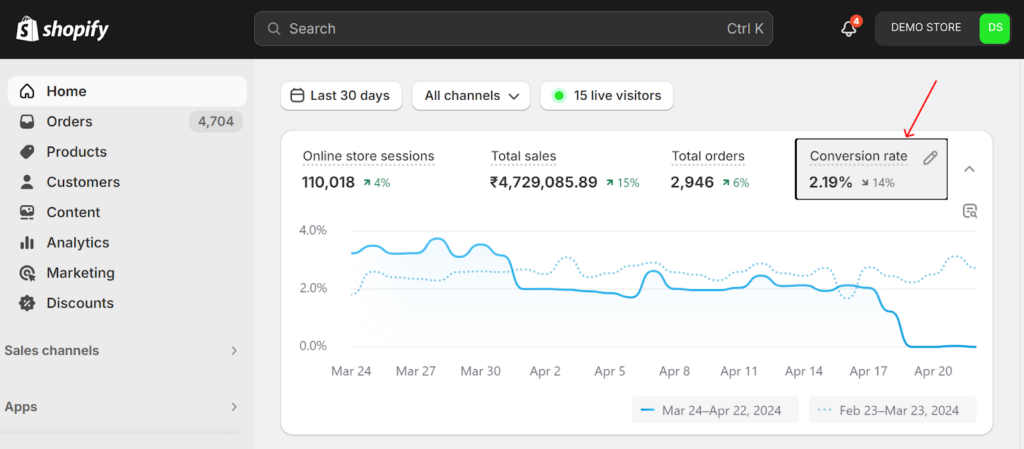
2) Shopify Analytics
For a more detailed view, explore Shopify Analytics. This built-in tool offers reports and breakdowns that can provide a deeper understanding of your conversion rate.
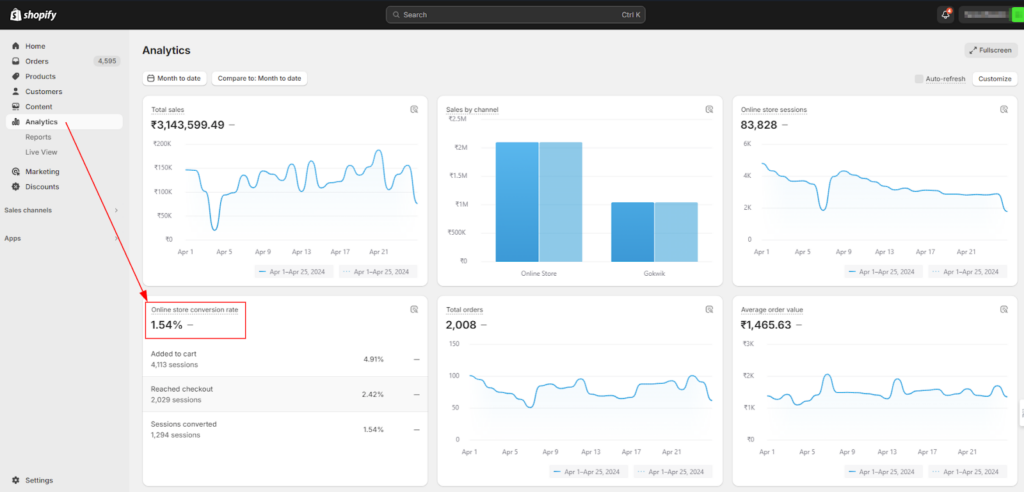
3) Google Ads
If you’re more comfortable with Google Ads, it can also help you with the conversion rate of your Shopify store.
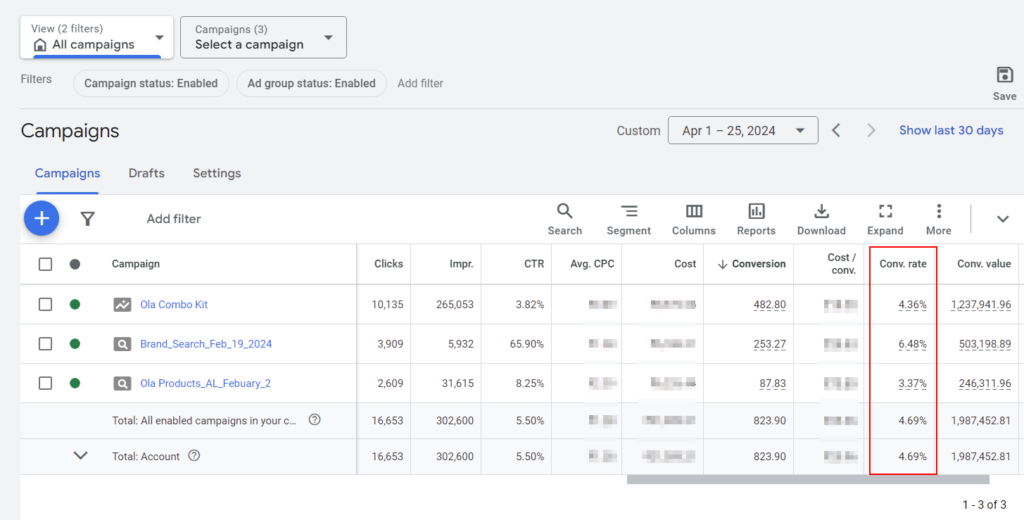
Step 2: Define and Track Your Goals
Now you need to set your goals for the conversion rates.
What do you want to achieve with your online store? Increase sales? Grow your email list?
Once you know your overall goals, you can start to identify specific conversion rate goals that will help you achieve them.
According to Shopify, average e-commerce conversion rates range from 2.5% to 3%. Anything more than 3.2% would put you in the best 20% of stores we benchmark for conversion rate, and more than 4.8% would put you in the best 10%.
Step 3: Study User Behavior
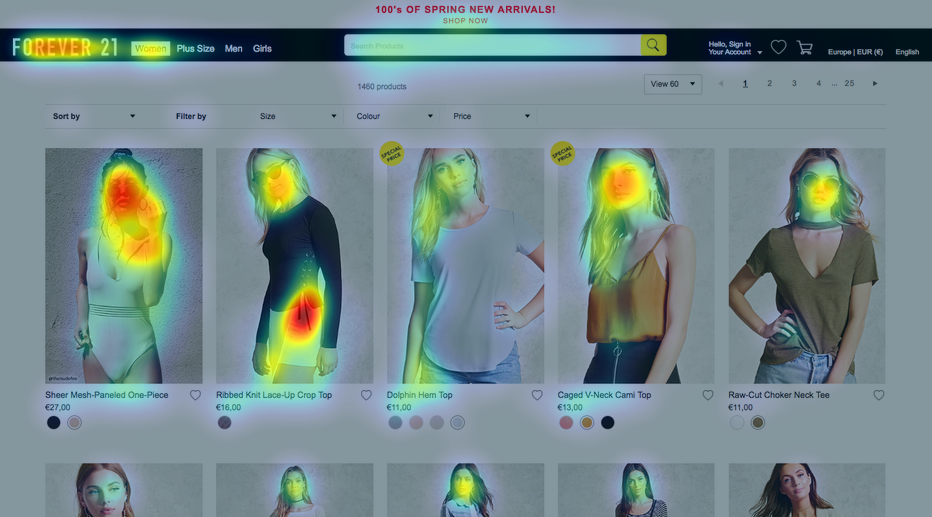
Let’s be honest here: if you don’t know how your Shopify store visitors are interacting with your site, you will never know what’s exactly going on with your store.
And to know how users are behaving in your store, it’s important to leverage tools that can give you solid insights. You can use heatmap tools like Hotjar, Crazy Egg, or Microsoft Clarity to catch the nerves of your store visitors.
Once you have installed the tool on your Shopify store, you can access the data of where users are clicking, scrolling, or spending the most time. With this data, try to understand patterns of user behavior and find out the areas for improvement.
By carefully analyzing this data over a period of time and in considerable quantity, you can definitely make informed decisions about your site layout, content, and design – ultimately leading to an improved conversion rate on your Shopify store.
Here’s an example of an eCommerce store!
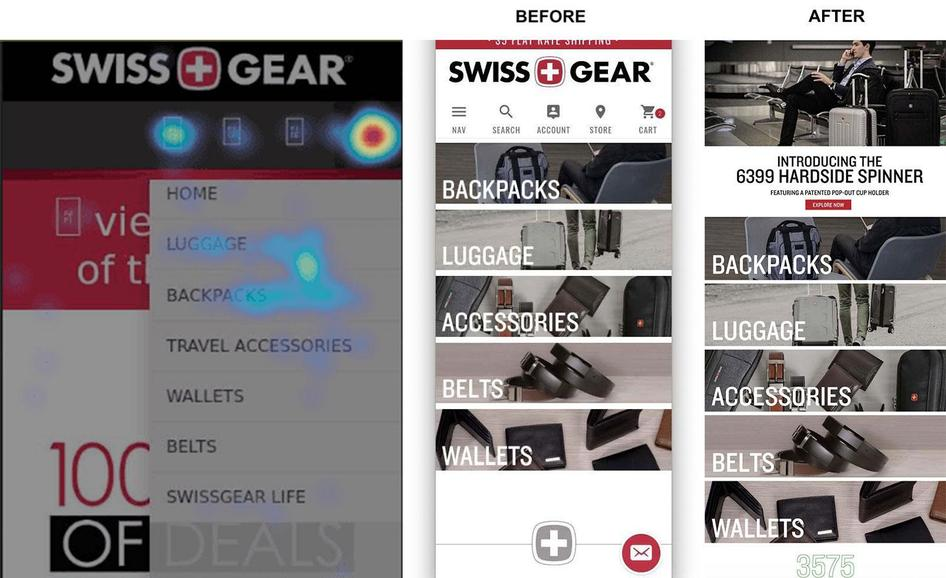
Source: Hotjar.com
These red areas show where users focus their attention. In the case of Swiss Gear, extensive red on the mobile menu signifies that users frequently interacted with it, and suggest they wanted to navigate the store.
Pay special attention to any pages with high drop-off rates or where users linger without converting. This could indicate areas of your site that are causing confusion or dissatisfaction.
At Aureatelabs, we offer strategies on how to modify these areas based on user behavior patterns. We ensure continuous tracking and analysis to iteratively improve the site’s user experience and conversion rate.
Step 4: Identify Drop-off Points
Pinpoint where potential customers leave your site. Is there a particular page that causes them to exit? Or perhaps the checkout process is too lengthy or confusing? Identifying these drop-off points can highlight specific areas for immediate improvement.
If certain pages have unusually high exit rates, which might suggest problems with content, layout, or load times, you need to optimize them.
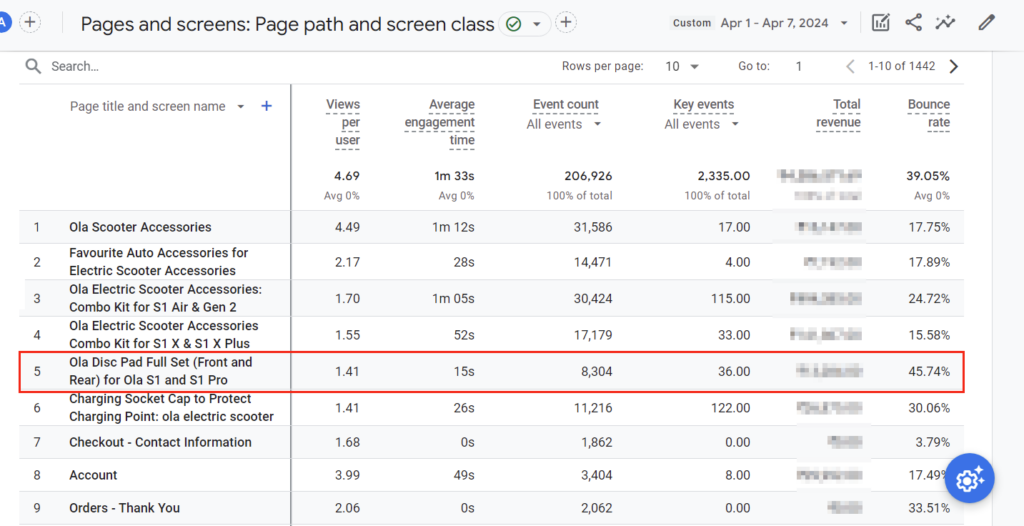
By following these steps, you can start to understand where your Shopify store excels and where there is room for improvement.
Continuously tracking these metrics and making informed adjustments based on your findings will help you improve your store’s conversion rate over time.
Now, let’s understand the common challenges that affect conversion rates.
What are the Challenges Impacting Conversion Rates?
Improving conversion rates isn’t just about tweaking colors or buttons; it’s about solving real problems that users encounter on your site.
Let’s explore some common challenges that Shopify store owners face.
High Bounce Rates
If visitors leave your site seconds after they arrive, it’s crucial to assess the first impression your store makes. Optimize your landing pages with clear, compelling headlines, faster load times, and engaging visuals that draw visitors deeper into your site.
Simplify navigation to make it intuitive and ensure that mobile users have just as smooth an experience as desktop users.
Cart Abandonment
A major pain point for many eCommerce sites is shoppers adding items to their cart but not completing the purchase.
To combat this, streamline your checkout process to reduce friction. Consider introducing guest checkout options, simplifying forms, and offering multiple payment methods.
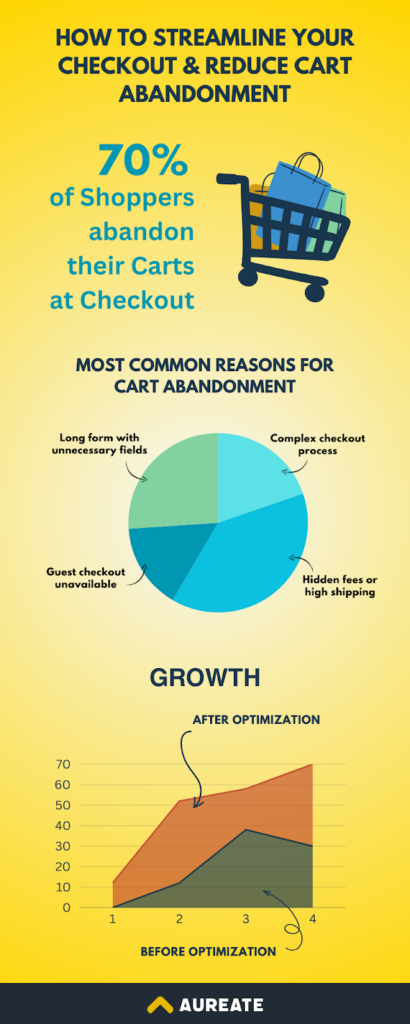
Consider implementing a one-step checkout process. Simplifying the checkout to a single step has been shown to increase conversions by up to 20x for our clients.
Additionally, implement cart abandonment emails to remind customers of what they’ve left behind and entice them back with a special offer or a reassuring message about security.
This approach not only makes it faster for customers to complete their purchases but also reduces the possibility of cart abandonment.
Poor Mobile Experience
With more than half of web traffic coming from mobile devices, a suboptimal mobile experience can severely hurt your conversions.
By addressing these common challenges, you can create a more user-friendly Shopify store that not only attracts but also retains and converts visitors into loyal customers.
Without further delay, let us learn the tried and tested strategies that can improve your site’s conversion capability.
How To Improve Shopify Conversion Rate?
Here are the Top 15 Strategies To Improve Shopify Conversion Rate:
- Work On Website Speed
- Make Your Store is Mobile-friendly
- Have Product Reviews and Social Proof
- Focus on User Experience (UX)
- Highlight Coupon Codes and Real-time Purchases
- Add Intelligent Search Functionality
- Feature High-Quality Product Images and Videos
- Have Intuitive Navigations
- Be Transparent About Price, Delivery Time, and Inventory
- Offer a Streamlined Checkout Process
- Retarget with Abandoned Cart Email Campaigns
- Implement Upselling and Cross-Selling Strategies
- Have Compelling Copies on Your Site
- Exceptional Customer Service
- Engagement After Purchase
Go through all the strategies mentioned below to achieve your conversion goals and take inspiration from the real-life examples I have mentioned.
1. Work On Website Speed
How many times has it been with you that you left a website because you had to wait for too long? At least once, right?
Imagine if your store visitors experience the same, they will never get a chance to explore your site – forget about shopping from it. Data from Google indicates that as page load time increases from one second to three seconds, the probability of a visitor bouncing increases by 32%.
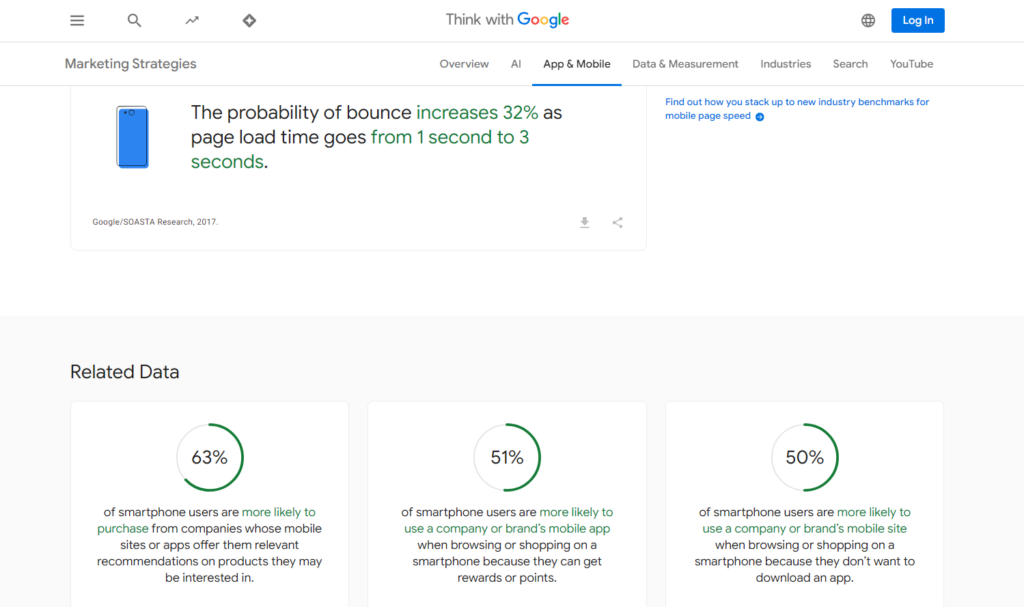
This highlights the direct impact that quick loading times can have on retaining visitors and boosting sales. According to Shopify, for the best user experience, your website loading speed should be less than or equal to 2500ms (2.5 seconds).
You can check your store’s current speed and performance issues by using tools like Google’s PageSpeed Insights or GTmetrix. And if your store speed is not up to the mark, you can check for the common Shopify mistakes slowing down your site and resolve them to speed up your store.
This reminds me of a client “Jungle Outlet” who was suffering from low performance. When they came to us, there were many challenges they were facing with their site, but Shopify speed optimization was their major objective.
Our in-house team of experts helped them improve their site from a Google Lighthouse score of 47 to 99 – which helped them get more user engagement instantly, leading to a better purchase experience in the store.
Here, you can see how we improved their score to almost 100 – leading to better conversions.
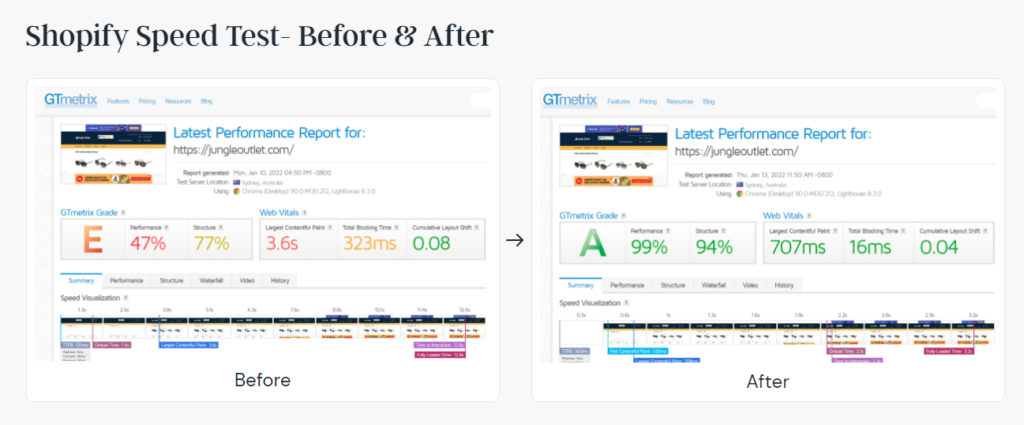
Impressive… right?? If you’re looking for a similar website speed for your Shopify store, you can immediately book our Shopify speed optimization service!
2. Make Your Store is Mobile-friendly
As 187.5 million people are expected to shop via their smartphone by 2024 and because these numbers are going to only increase day by day, it’s important to keep your Shopify store mobile-friendly for an increased conversion rate.
Here are some of my personal recommendations to keep your Shopify store mobile-friendly:
👉 Use a responsive Shopify theme that automatically adjusts to different screen sizes and resolutions.
👉 Keep your navigations intuitive and simple for a smooth User Experience (UX).
👉 Ensure a limited-step (if possible, within two to three taps) checkout process so that a user doesn’t leave your site at the end moment.
👉 Offer popular mobile payment options like Apple Pay, Google Pay, and PayPal to streamline the payment process.
This is how we made sure the store is fully responsive when we were developing a Shopify Headless store for our client Pure Daily Care!

3. Have Product Reviews and Social Proof
I’m sure whenever you go out for dinner, you check the ratings of the restaurant before going there, right? The same happens with your store visitors when they are checking a product.
When you have reviews embedded on product pages, it provides confidence to your customers to make a purchase.
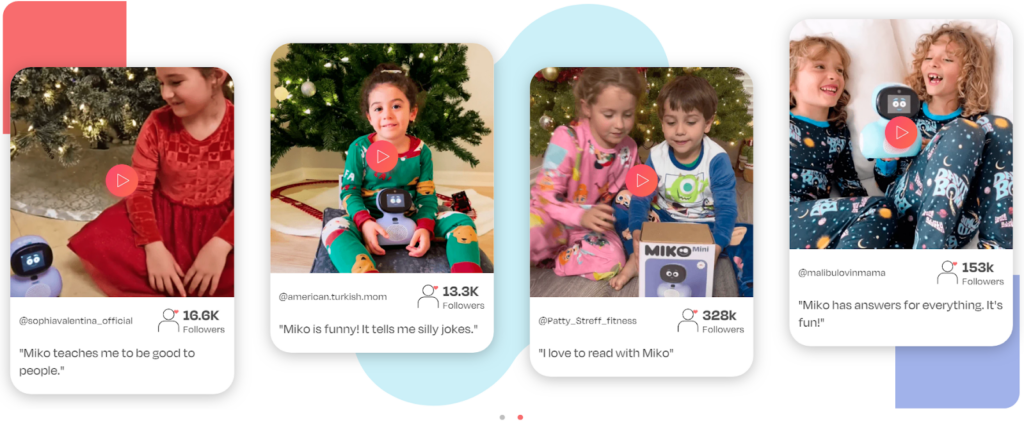
You can see in the above example how Miko – one of our Shopify client, has strategically placed UGC content as reviews and social proof on their site to build trust among buyers.
You can use Shopify apps like Yotpo, Judge.me, or Stamped.io to easily collect and display customer reviews and ratings on your product pages.
But it’s easier said than done. If you own a Shopify store, you would know that there will be very few users who would share their reviews on the site. To solve this issue, you can enable automated follow-up emails for reviews in exchange for discounts on future purchases.
PRO TIP: Highlight user-generated content (UGC) or photos of happy customers with your product in sidebars to increase conversions.
4. Focus on User Experience (UX)
As I keep working with more and more Shopify stores, I can say that User Experience is the king of online shopping. If you fail to provide a great experience to your visitors, you lose the game within seconds.
When your website has a seamless UX, users stay on your site longer as every activity, from finding the right product to checking out, feels like a smooth flow.
Based on my experience, here are three main and most effective elements you can have on your store for great UX –
👉 Interactive Elements
Incorporate interactive features such as hover effects, image zooms, and dynamic product recommendations to make browsing your store more engaging. These elements provide immediate visual feedback that rewards user interaction, making the browsing experience more engaging.
For example, Crate&Kids is a Shopify store that leverages interactive features of the platform to create a visually engaging and informative browsing experience for their products. When hovering over a product image, a subtle zoom effect enlarges the product, allowing for a closer look at details like materials and craftsmanship.
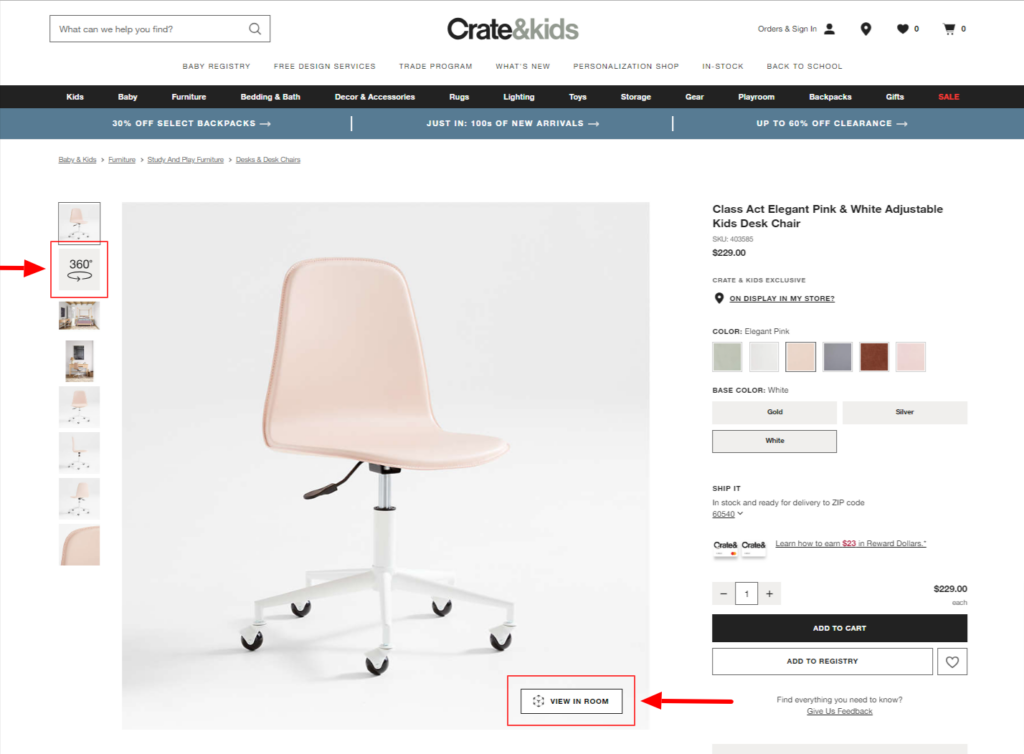
Some products offer 360-degree views. Users can virtually rotate the product to see it from all angles, mimicking the experience of holding it in person. This can be particularly helpful for showcasing intricate details or multiple color options.
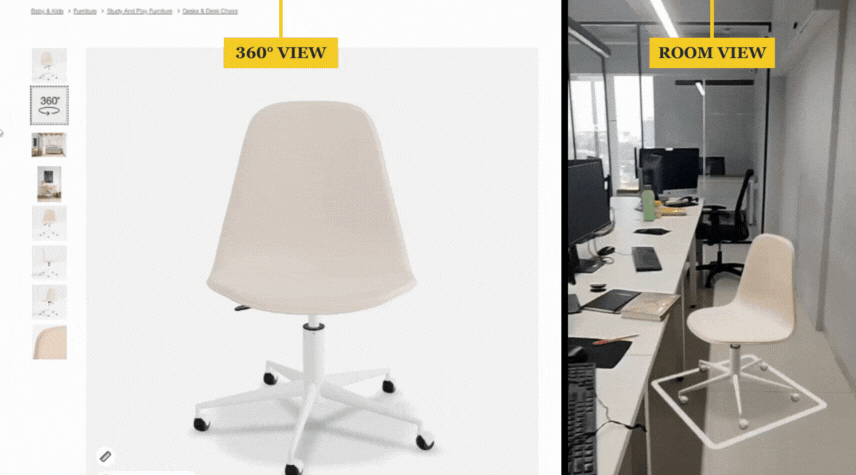
👉 Gamification & Surveys
Introduce elements of gamification such as loyalty points, badges for repeated purchases, or fun interactive quizzes that recommend products based on answers. These design elements not only make the user’s journey fun but also increase the likelihood of conversions.
These design strategies help you boost engagement and create a more memorable user experience that encourages visitors to stay longer and interact more deeply with your Shopify store.
If you’re looking for expert guidance or need a tailored solution to boost your Shopify store’s user experience, consider exploring our eCommerce design services.
5. Highlight Coupon Codes and Real-time Purchases
Who doesn’t like having some extra discounts and offs, right? It works like having a sweet dish after a meal.
When you highlight coupon codes and discounts, you give your visitors one more reason to buy products from you – improving your Shopify conversion rate.
Moreover, you can show the real-time purchases happening in your store to create fear of missing out (FOMO) and increase the perceived value of the product.
You can do this by either having pop-ups on the product pages or a sticky banner that shows special promotions, discounts, or limited-time offers.
To show real-time purchases, you can use apps like SalesPush and SalesPop.
PRO TIP:
You can improve your Shopify conversion rate by offering exclusive discounts or freebies when a user completes a purchase.
6. Add Intelligent Search Functionality
Did you know that 69% of consumers go straight to the search box when they visit an online store?
By adding intelligent search functionality to your store, you can serve all of these customers in a better way – leading to enhanced conversion rates.
Plus, you can use features like popular searches, autocomplete suggestions, filters, and sorting options so that your visitors don’t have to put in much effort.
Here are some features that you can add to your functionality search to be more advanced than most of the eCommerce stores out there:
👉 Allow error tolerance for spelling mistakes
👉 Offer personalized search results based on their gender and past search history
👉 Recommend alternative products when the original product is not available
👉 Enable autocomplete in your search results and suggestions
👉 Have facets and filters to narrow down the results
If you want to have such features in your search functionality, you can install and configure search apps (like Fast Simon Search and Filters and Smart Product Filter & Search) on your Shopify Store and get started.
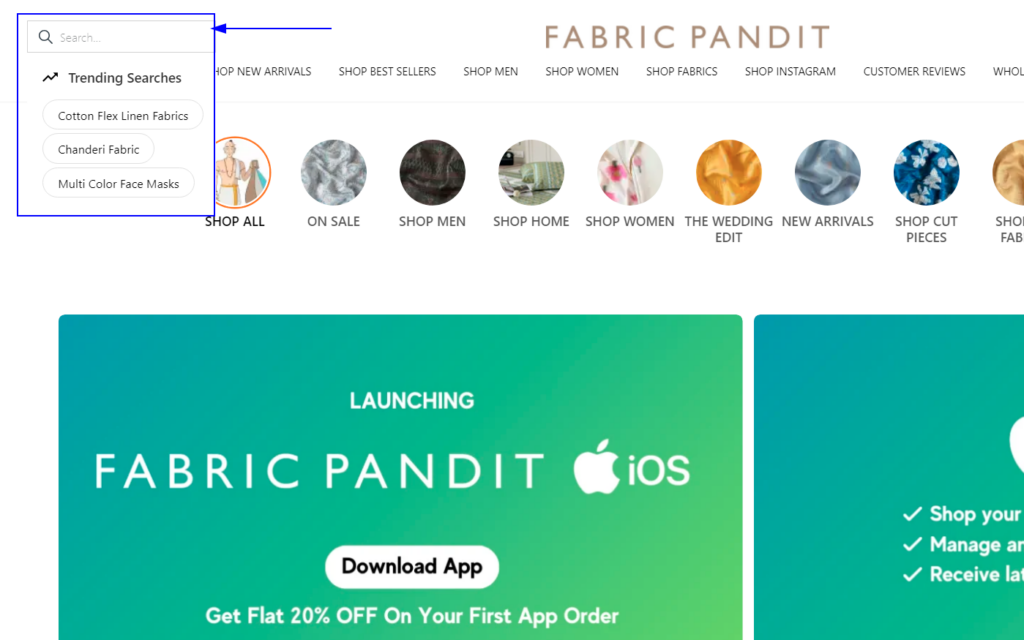
For example, when we implemented the same functionality for our recent client, Fabric pandit, they saw better sales and conversion rates on their site.
7. Feature High-Quality Product Images and Videos
As humans are 60,000 times faster at visual communication, you can leverage it to influence your users’ buying decisions. And not only that, research also shows that brands using visual content tend to see 7x higher conversion than those who don’t.
Keeping this in mind, it’s crucial to invest in professional photography to highlight your products in the best light. Also, shoot products from multiple angles to give customers a comprehensive view.
However, keep in mind that you optimize image load times without sacrificing quality.
If you see the top-notch brands in the world, they will always highlight the lifestyle in their shoot rather than just the products because people buy emotions along with your products.
PRO TIP:
Shoot bite-sized and engaging videos that beautifully
capture the use cases of your product.
8. Have Intuitive Navigations
How would you feel if you had to think too much and do a lot of to and fro before you get to the right category of products you are looking for? Frustrating, right?
When your users experience cognitive load during online shopping, they are more likely to abandon carts and leave the purchase without completing it.
To solve this issue, you must design clear and intuitive navigations for your store.
The best activity you can do to find intuitive pathways for your industry is to research your top competitors and analyze how they have strategically designed their store architecture. It’s always recommended to choose common and descriptive category names rather than fancy and complex ones.
You can also have a mega menu and breadcrumbs at the top so the users can find product locations within a few taps.
Lastly, ensure your store navigation is collapsible and has a touch-friendly interface for easy use on mobile devices.
9. Be Transparent About Price, Delivery Time, and Inventory
Moving forward, another important aspect you should consider to improve your Shopify conversion rate is product updates. The more clear and precise information you provide about price, delivery time, and inventory, the better decisions your visitor can make about their purchase.
If they can see that a product will be delivered to them within two days, they are more likely to make a purchase compared to a scenario where they have no idea when their product will be delivered.
In the same way, when you show them all the prices on the product page itself, they will not bounce from the checkout page after seeing extra shipping and delivery charges.
To give you a quick example, we can look at the product page of Milly & Henry. You can see how they have mentioned all the essential information so that users don’t bounce at the checkout page.
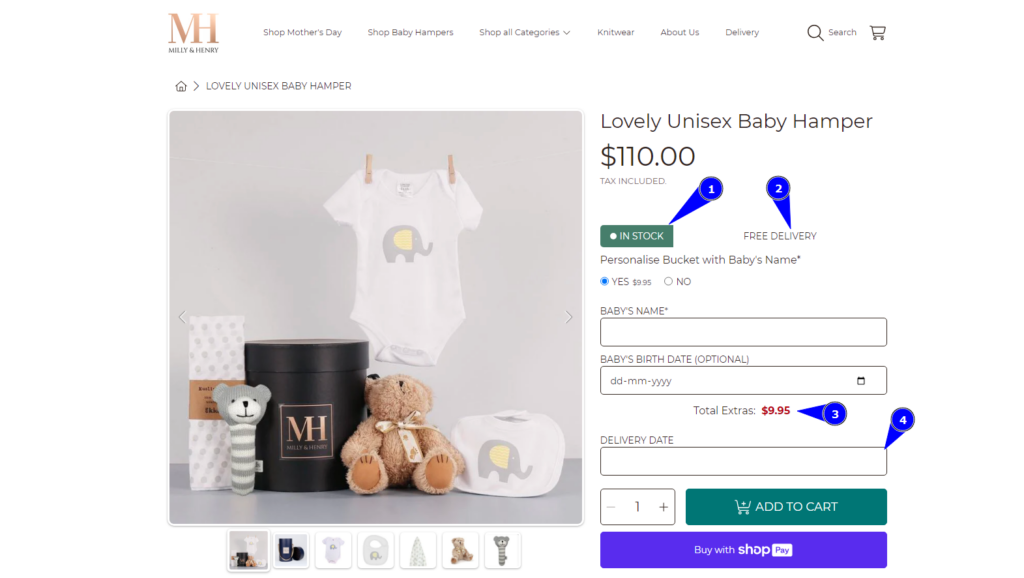
10. Offer a Streamlined Checkout Process
Make the checkout process as quick and simple as possible. Here’s how you can effectively do this:
👉 Prefills for Faster Checkout
According to Google, auto prefills save 30% of users time – resulting in more success at checkout pages.
You can either store customer accounts or use cookies to remember past data such as name, shipping address, and email address to enable auto prefill. This way, you not only save them more time but also improve your Shopify store’s conversion rate.
👉 Multiple Payment Options
Offering multiple payment methods can add more convenience. Include various payment methods such as credit cards, digital wallets like PayPal, and mobile payments.
This makes it easier for more customers to buy without hassle.
👉 Guest Checkout Option
According to Baymard Instutue’s research, 26% of users don’t make a purchase because they need to create an account for that! Imagine a portion of the revenue you will use when you make account creation mandatory for your store.
Give a choice to your users whether they would like to create an account or checkout as a guest by having respective buttons on the checkout page. To check the effectiveness of this strategy, you can track guest checkout conversion rates and optimize the process based on customer behavior and feedback.
This approach aims to remove any obstacles in the buying process, enhancing customer experience and potentially increasing your store’s conversion rates. What if I say that you can achieve everything just with a single integration with GoKwik’s powerful checkout solution?
Yes, you heard right! Aureate Labs has partnered with GoKwik which enable us to help eCommerce businesses to streamline their checkout processes and ensure reduced cart abandonment.
Here’s a live example of successful GoKwik integrations!
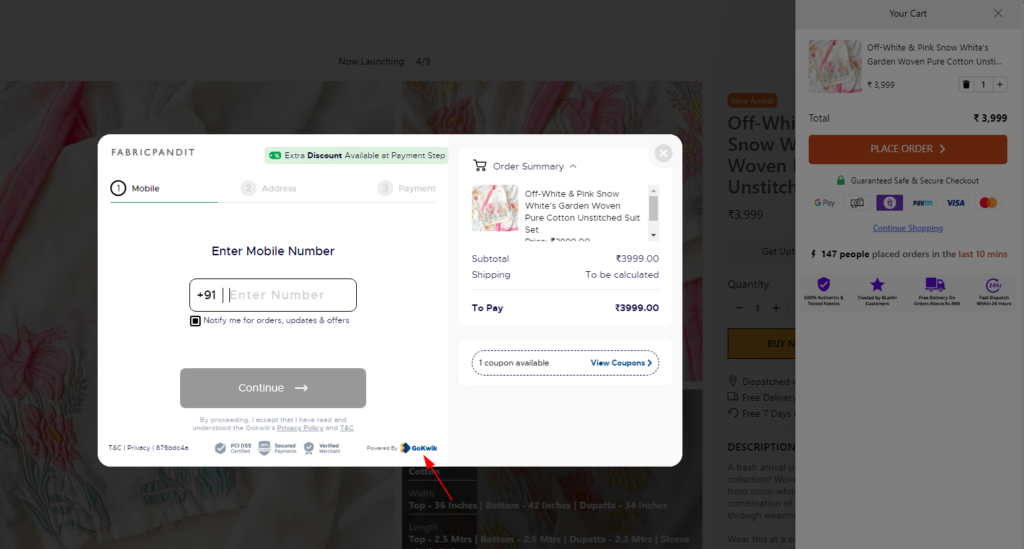
11. Retarget with Abandoned Cart Email Campaigns
I’m sure you must have gotten emails when you left a product in a cart at an eCommerce store, right?
Because cart abandonment emails have 41.18% open rates and play a crucial role in recovering lost sales.
Here’s how you can make your abandoned cart email campaigns even more effective:
👉 Set up automated email sequences for cart abandonment that send timely reminders to customers about their incompetent purchases.
👉 Craft catchy and irresistible email subject lines that tempt your customers to open the email.
👉 Customize email content with personalized product recommendations, special offers, or discount codes for even better conversions.
👉 Analyze past data and optimize abandoned cart email timings based on customer behavior and preferences.
👉 Keep experimenting with different email copy, designs, and offers to see what is working best for your audience.
See how our client “Fabric Pandit” does it effectively:

12. Implement Upselling and Cross-Selling Strategies
Leveraging upselling and cross-selling strategies can work as a magic tool for better conversion rates and overall profitability.
To do this, you can create a product bundle of complementary items or offer upgrade items with a better valuation that encourages users to make an immediate purchase.
Use data from customer behavior, such as past purchases, viewed products, and search history, to offer personalized recommendations like:
- Personalized Product Recommendations
- Personalized Deals
- Dynamic Pricing
- Personalized Reminder Emails
- On-site Targeting Customers
- Upselling and Cross-Selling
This not only makes the shopping experience more relevant but also increases the chances of purchases.
Here’s an example of personalized product recommendations, that one of our clients has implemented in their store!
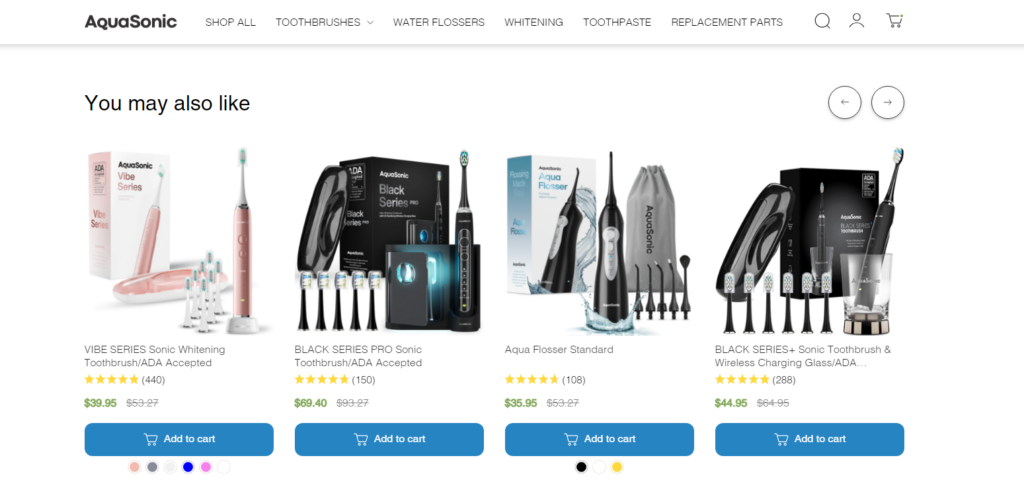
As users browse the collection, personalized recommendations appear based on their selections or browsing history. This helps users discover similar styles or complementary accessories, potentially leading to increased basket sizes and sales.
Strategically place these recommendations on product pages, during the checkout process, and even on the thank you page after purchase.
The key is to make suggestions when customers are most likely to be receptive to adding items to their carts.
13. Have Compelling Copies on Your Site
Captivating copies – a very simple yet the most effective tool you can craft on your site to give a unique voice to your brand. And less is more when it comes to eCommerce landing pages and product pages.
If you observe any great copy, you will see they are designed to pursue you without you knowing about it. To do the same for your store, sell the sizzle, not the steaks.
Effective storytelling can captivate shoppers and build a stronger emotional connection.
Here’s how you can do it right:
👉 Content-Rich Storytelling
Create detailed blog posts, articles, or videos that share the stories behind your products. This content should be rich in keywords that potential customers might use to find products like yours, improving your search engine rankings and drawing more visitors to your site.
👉 Visual Storytelling
Accompany your narratives with high-quality images and videos that illustrate your points, making the stories not just informative but also visually appealing. This multimedia approach helps in retaining visitor interest and can lead to higher engagement rates.
And, combine all of these with a powerful call-to-action (CTA) button that your visitors can’t resist but buy.
14. Exceptional Customer Service
Trust is the foundation of any strong relationship, and loyal customers are the ones who trust you to deliver a great experience every time. When customers feel heard, understood, and valued, they’re more likely to trust your brand.
So, how do you make exceptional customer service a reality?
Here are a few tips:
👉 Give your customer service reps the knowledge and resources they need to solve problems efficiently and creatively.
👉 Every customer is unique, so treat them that way. Take the time to understand their needs and tailor your response accordingly.
👉 Don’t wait for customers to come to you with problems. Anticipate their needs and offer solutions before issues arise.
👉 A simple “thank you” can go a long way. Let your customers know you value their business.
So, customer service isn’t just about solving problems. It’s about building relationships. It’s the friendly voice on the other end of the phone who remembers your name and goes the extra mile. It’s the email response that feels more like a helpful conversation than a robotic template.
15. Engagement After Purchase
The customers today have lots of options.
So, how do you turn that one-time purchase into loyalty that keeps them coming back for more? The answer lies in post-purchase engagement.
And, the real journey to building a loyal customer base starts after they hit “purchase”.
Suppose, you just bought a new pair of shoes. Wouldn’t it be awesome if the store sent you a quick video tutorial on how to clean different materials? Or maybe some styling tips to help you get the most out of your purchase? These little efforts show you care and that you want them to have a fantastic experience with your product.
Now that you know why engagement is key, how do you actually do it? Here are a few ideas to get you started:
👉 Welcome emails: A simple “thanks for your purchase” email goes a long way. Add a touch of personality and include helpful resources related to their purchase.
👉 Educational content: Offer tutorials, FAQs, or blog posts that answer common questions and help customers get the most out of your product.
👉 Loyalty programs: Reward repeat customers with exclusive discounts or early access to new products. This incentivizes further purchases and creates a sense of community.
👉 Personalized recommendations: Based on their purchase history, suggest complementary products they might find useful.
👉 User-generated content campaigns: Encourage customers to share photos or videos using your product with a branded hashtag. This creates a sense of community and provides valuable social proof.
Focus on providing value, building relationships, and making your customers feel like they’re part of something special.
Why Choose Aureate Labs for Shopify Conversion Optimization?
Conversion optimization has many pillars! It’s not only website speed or eCommerce UI/UX design. And, if you want to accelerate your conversion, you need more than a performance analysis or speed optimization.
Aureate Labs is your ideal partner for your Shopify Conversion Optimization. Our experts will conduct a complete store audit that will help pinpoint issues that may be the silent conversion killers. And we’ll optimize your Shopify website for overall growth. So that, you always deliver a top-tier shopping experience.
Be it a high bounce rate, cart abandonment, or lack of customer engagement in your store, our in-house team of experts has helped many clients achieve amazing results and we are sure that we can do that for you too!
Case Studies and Success Stories
Let’s explore some real-world case studies from Aureate Labs that demonstrate the significant impact of our expert Shopify design and development:
D2C From Labs to Household
Aureate Labs crafted a Headless PWA for Miko, a notable player in the Computers & Electronics Manufacturing industry in the USA. This project was executed to enhance online presence and streamline customer interaction, significantly boosting Miko’s market reach and user engagement. View the case study.
B2C Wellness Brand
In just 8 weeks, Aureate Labs delivered a headless store for an online wellness brand based in Los Angeles. This rapid deployment focused on enhancing user experience and optimizing performance, leading to improved sales and customer satisfaction. View the case study.
These examples prove our expertise in leveraging Shopify technology to create tailored eCommerce solutions that drive success and growth.
Together, we can transform your Shopify store into a high-converting, customer-centric online shopping experience.
Email us at hello@aureatelabs.com or fill in the contact form to take your eCommerce store to the next level today!
Thank you for joining us on this journey to elevate your Shopify store. Here’s to your success in the competitive world of eCommerce!






Post a Comment
Got a question? Have a feedback? Please feel free to leave your ideas, opinions, and questions in the comments section of our post! ❤️